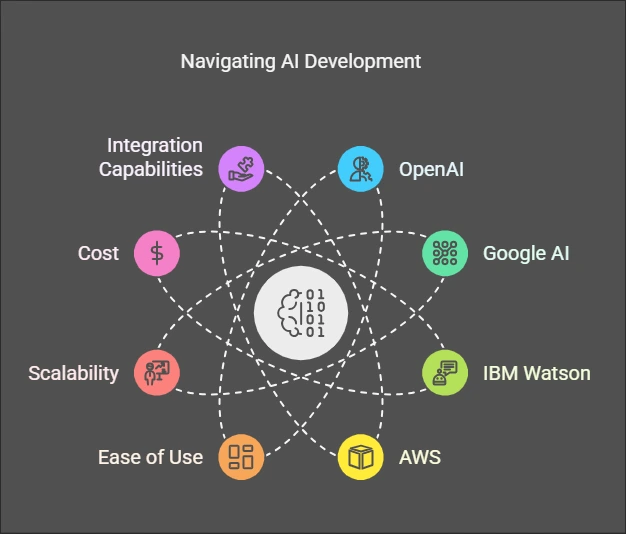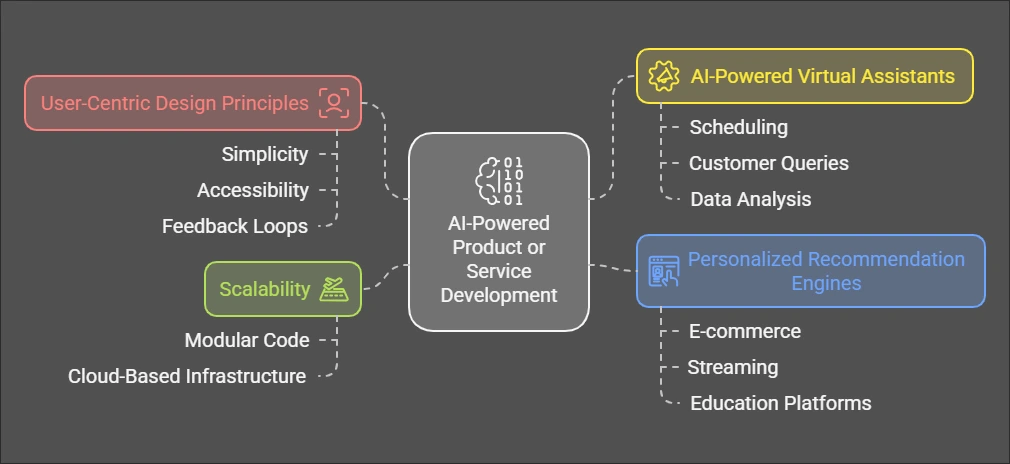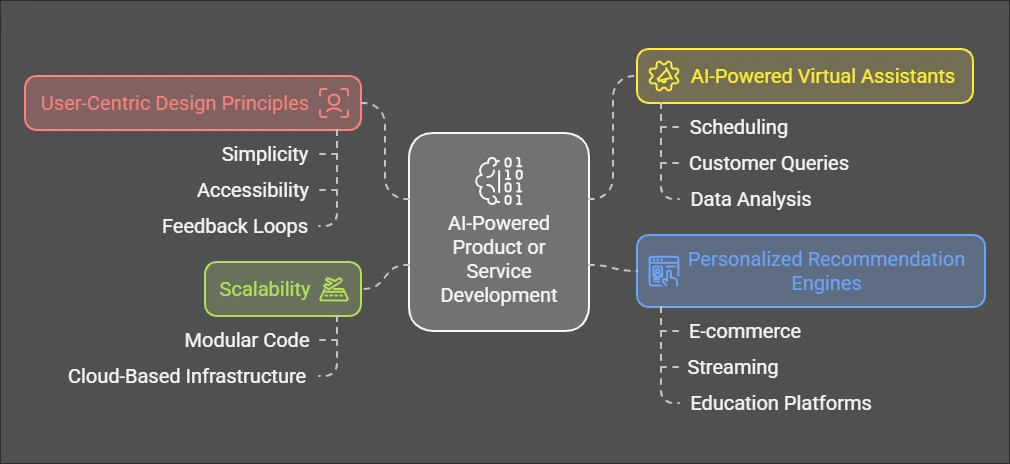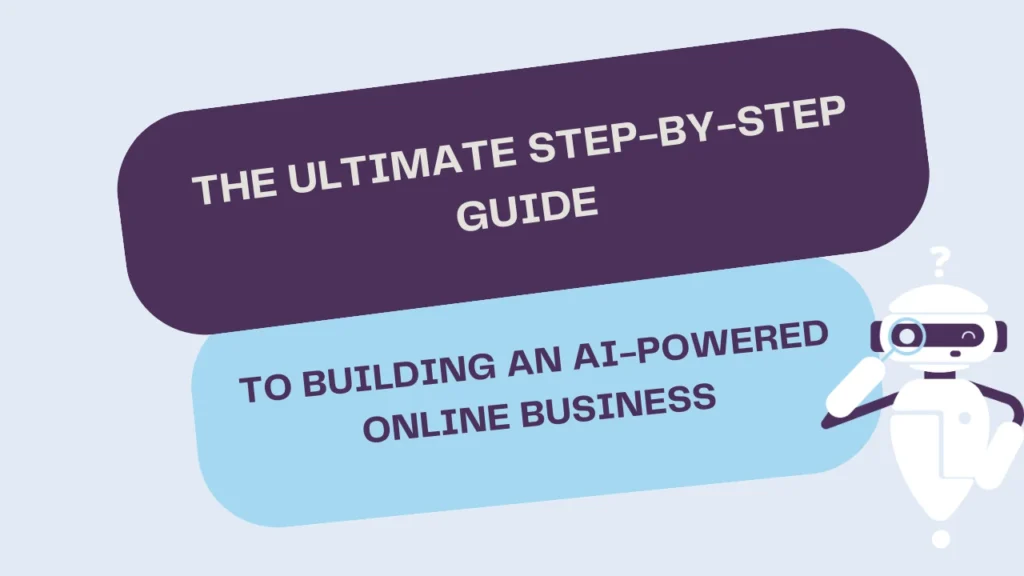Table of Contents
Introduction
Artificial Intelligence (AI) is no longer just a futuristic concept confined to science fiction. It has become an integral part of modern life, reshaping industries, revolutionizing workflows, and opening doors to new business opportunities. Whether you’re a tech-savvy entrepreneur or someone with a vision to innovate, AI can be the key to building a thriving online business in today’s competitive landscape.
This guide will walk you through everything you need to know about starting an AI-powered online business. From understanding the fundamentals of AI to identifying the right business model and niche, you’ll learn how to transform your ideas into reality.
Why AI is Transforming Online Businesses
The digital world thrives on innovation, and AI has emerged as a powerhouse of change. With its ability to process massive amounts of data, learn patterns, and make intelligent decisions, AI enables businesses to operate more efficiently than ever before. Tasks that once required significant time, effort, and human resources can now be automated, allowing entrepreneurs to focus on strategic growth.
For example, AI-driven tools can handle customer service through chatbots, recommend personalized products to customers, and even optimize advertising campaigns. This adaptability is why AI is transforming how businesses connect with their audiences, streamline operations, and stay competitive.
Benefits of Starting an AI-Powered Online Business
- Cost Efficiency: AI reduces the need for large teams by automating repetitive tasks, saving money on operational costs.
- Scalability: AI solutions grow with your business. As demand increases, your AI systems can adapt without major overhauls.
- Improved Customer Experience: Personalization powered by AI can lead to happier, more loyal customers.
- Future-Proofing: By adopting AI, you position your business to thrive in an increasingly technology-driven market.
Want to leverage AI to build a profitable online business but don’t know where to start? 🚀 Our beginner-friendly guide walks you through everything you need to know to launch and scale with AI. Don’t miss out—grab your copy of “How to Build an AI-Powered Online Business: A Beginner’s Guide” today! 👉 Get your eBook now!
Who Can Benefit from This Guide?
This guide is for anyone looking to embrace AI and carve out a niche in the digital economy. Whether you’re a budding entrepreneur, an established business owner, or simply curious about leveraging AI for financial independence, this step-by-step roadmap will provide actionable insights to help you get started.
Part 1: Understanding AI and Its Applications
1.1 What is Artificial Intelligence?
Definitions and Key Concepts
Artificial Intelligence refers to the development of computer systems capable of performing tasks that typically require human intelligence. These tasks include problem-solving, learning, reasoning, and natural language processing. AI isn’t a singular technology but a broad field encompassing various techniques and tools designed to make machines “smart.”
Types of AI
- Narrow AI: Focused on specific tasks, such as recommendation algorithms or virtual assistants.
- General AI: A hypothetical form of AI that can perform any intellectual task a human can.
- Super AI: A futuristic concept where AI surpasses human intelligence in every field.
While most applications today use Narrow AI, advancements are pushing the boundaries toward more general capabilities.
1.2 Why AI is a Game-Changer for Businesses
Automation and Efficiency
AI eliminates repetitive and mundane tasks, freeing up time and resources for more strategic initiatives. From automating customer service to managing supply chains, AI ensures businesses run smoothly and cost-effectively.
Enhanced Customer Experiences
Modern customers demand personalization. AI can analyze user behavior to tailor recommendations, improve interactions, and create unique customer journeys, leading to better satisfaction and loyalty.
Data-Driven Decision Making
AI thrives on data. It processes vast amounts of information quickly and accurately, helping businesses uncover insights, predict trends, and make informed decisions that drive growth.
If you’re looking to start and grow your online business successfully, don’t miss out on our expert guide! 🚀 Get your copy of “From Zero to Hero: A Step-by-Step Guide to Making Money Online” today and start building your financial freedom. 👉 Grab your eBook now!
Part 2: Choosing Your AI-Powered Business Model
2.1 Popular AI Business Models
AI as a Service (AIaaS)
In this model, businesses offer AI-powered solutions through subscription-based platforms. Examples include machine learning platforms or cloud-based analytics tools.
Product-Based AI Solutions
This model focuses on selling tangible AI-driven products like smart home devices, AI-enabled software, or wearable technology.
AI-Powered Digital Services
Entrepreneurs can provide services such as virtual assistance, personalized coaching, or content creation powered by AI tools.
2.2 Identifying Your Niche
Market Research Strategies
Start by exploring market trends, understanding customer pain points, and identifying opportunities where AI can add value. Tools like Google Trends, industry reports, and online forums can provide valuable insights.
Evaluating Competition
Study your competitors to see what they’re doing well and where they fall short. Use this knowledge to differentiate your offering.
Choosing a Profitable Niche
Focus on areas with high demand and low competition. Consider industries like healthcare, e-commerce, or education, which are rapidly adopting AI to solve specific problems.
By understanding these foundational elements, you’re already on the path to creating an AI-powered online business that stands out in today’s digital ecosystem.
Part 3: Essential Tools and Resources

3.1 AI Development Platforms
Overview of Leading Platforms (e.g., OpenAI, Google AI)
AI development starts with selecting the right platform. Today, several powerful AI platforms make it easy for businesses to leverage advanced AI technologies without needing to build systems from scratch.
- OpenAI: Known for its robust tools like ChatGPT and GPT-4, OpenAI excels in natural language processing, making it a popular choice for chatbots, content generation, and virtual assistants.
- Google AI: Google’s AI platform offers powerful tools like TensorFlow and Vertex AI, which support machine learning and AI model deployment.
- IBM Watson: A leader in AI-driven analytics, IBM Watson specializes in data processing, conversational AI, and industry-specific applications.
- Amazon Web Services (AWS): AWS provides AI services such as SageMaker for machine learning, Rekognition for image analysis, and Lex for building conversational interfaces.
Criteria for Selecting the Right Platform
Choosing the best AI platform depends on your business needs and technical expertise. Consider these factors:
- Ease of Use: Look for platforms with user-friendly interfaces and accessible documentation.
- Scalability: Ensure the platform can grow with your business and handle increasing demands.
- Cost: Compare pricing models to find one that fits your budget without sacrificing functionality.
- Integration Capabilities: Check if the platform works seamlessly with your existing systems.
3.2 Integrating Third-Party Tools
Chatbots, Analytics, and Automation Software
Third-party tools are invaluable for enhancing your AI-powered business. Popular integrations include:
- Chatbots: Tools like Drift, Intercom, and ManyChat can automate customer interactions and improve response times.
- Analytics Tools: Platforms like Google Analytics, Mixpanel, and Tableau can help you track performance and make data-driven decisions.
- Automation Software: Tools like Zapier and HubSpot automate repetitive tasks, increasing efficiency and reducing human error.
APIs for Seamless Integration
APIs (Application Programming Interfaces) simplify the process of connecting third-party tools with your platform. For example:
- Twilio API: Enables AI-driven communication through SMS and voice calls.
- Stripe API: Facilitates secure online payments for your AI services or products.
- RESTful APIs: Allow you to integrate various software solutions effortlessly, ensuring smooth operations.
Part 4: Setting Up Your AI Infrastructure
4.1 Hardware and Cloud Solutions
Hardware Requirements for AI Applications
AI applications require significant computing power, especially for training complex models. Key considerations include:
- GPUs: Graphics Processing Units are essential for handling large-scale computations.
- Edge Devices: If your application involves IoT or real-time processing, edge devices with built-in AI capabilities may be necessary.
Benefits of Cloud Computing for AI
Cloud computing offers a cost-effective, scalable alternative to expensive hardware. Major providers like AWS, Google Cloud, and Microsoft Azure allow you to:
- Access high-performance computing resources on demand.
- Store vast amounts of data securely.
- Scale your operations as your business grows.
4.2 Building AI Algorithms and Models
Supervised vs. Unsupervised Learning
- Supervised Learning: Involves training AI using labeled data. Ideal for tasks like classification and prediction, where outcomes are clearly defined.
- Unsupervised Learning: Uses unlabeled data to identify patterns or groupings. It’s useful for applications like customer segmentation and anomaly detection.
Prebuilt Models vs. Custom AI Development
- Prebuilt Models: Platforms like OpenAI provide ready-to-use models that save time and effort. These are great for businesses seeking rapid deployment.
- Custom Development: For unique needs, building AI models from scratch offers greater flexibility and control, though it requires specialized expertise.
Part 5: Creating Your Product or Service

5.1 Designing an AI-Powered Product
User-Centric Design Principles
The success of any AI product hinges on how well it serves its users. Focus on:
- Simplicity: Make the interface intuitive and easy to navigate.
- Accessibility: Ensure your product caters to diverse user needs, including those with disabilities.
- Feedback Loops: Incorporate mechanisms for users to provide feedback, enabling continuous improvement.
Ensuring Scalability
From the outset, design your product to handle growth. This includes:
- Using modular code to facilitate updates and new features.
- Opting for cloud-based infrastructure to accommodate increased traffic.
5.2 Service-Based AI Business Ideas
AI-Powered Virtual Assistants
Virtual assistants are in high demand, helping businesses manage tasks like scheduling, customer queries, and data analysis. Examples include AI tools for HR, sales, and marketing teams.
Personalized Recommendations Engines
Recommendation engines, like those used by Netflix and Amazon, analyze user preferences to suggest tailored products or services. This application works well in e-commerce, streaming, and education platforms.
By implementing the right tools, infrastructure, and innovative product ideas, you’re setting the foundation for a successful AI-powered online business.
Part 6: Developing Your Website or Platform
6.1 Building a User-Friendly Website
Choosing the Right CMS or E-Commerce Platform
Your website is the backbone of your AI-powered business. Choosing the right platform depends on your specific needs:
- WordPress: A versatile option for blogs, e-commerce, and service-based businesses. Plugins like WooCommerce and AI-powered tools make it highly adaptable.
- Shopify: Perfect for AI-driven e-commerce businesses, offering integrations with AI tools for product recommendations and inventory management.
- Custom-Built Platforms: For businesses with unique requirements, custom websites provide greater flexibility, albeit with higher development costs.
Essential Features for an AI Business
- Fast Loading Speeds: Ensure your site is optimized for performance to keep users engaged.
- AI Integrations: Chatbots, recommendation engines, and personalized experiences should be central to your platform.
- Mobile Optimization: A significant portion of traffic comes from mobile users, so ensure your website is responsive.
- Secure Payment Systems: For e-commerce, robust and secure payment gateways are essential to building trust.
6.2 Integrating AI into Your Website
Embedding Chatbots
Chatbots like ChatGPT or Drift can automate customer interactions, offering 24/7 support and reducing response times. A chatbot can:
- Answer FAQs.
- Gather user data for personalized suggestions.
- Direct visitors to the right resources or services.
Personalizing User Journeys
AI tools can tailor the user experience based on behavior and preferences. Examples include:
- Dynamic content suggestions (e.g., recommending products based on browsing history).
- Customized landing pages for different customer segments.
Part 7: Marketing Your AI-Powered Business

7.1 Leveraging Content Marketing
Blogs, Whitepapers, and Case Studies
Content marketing is a powerful tool to showcase your expertise.
- Blogs: Write educational content about AI trends, your services, and their benefits.
- Whitepapers: Offer in-depth insights into how your AI solutions solve specific problems.
- Case Studies: Highlight success stories to build trust and credibility with potential customers.
Showcasing AI Success Stories
Share examples of businesses that have thrived using your AI-powered solutions. This could include testimonials, before-and-after metrics, or video interviews with satisfied clients.
7.2 Paid Advertising Strategies
Targeting AI Enthusiasts and Businesses
Use targeted ads to reach audiences interested in AI. Platforms like Google Ads, LinkedIn, and Facebook offer precise targeting options, such as:
- Keywords related to AI and business innovation.
- Demographics like business owners, entrepreneurs, and tech enthusiasts.
Measuring ROI
Track ad performance using metrics like click-through rates (CTR), conversion rates, and customer acquisition costs. Tools like Google Analytics and Facebook Ads Manager provide detailed insights to optimize your campaigns.
Part 8: Managing Your Business for Growth
8.1 Analyzing Performance Metrics
Key KPIs for AI Businesses
Regularly evaluate your performance using these metrics:
- Customer Retention Rate: Measures how well you’re maintaining customer relationships.
- Conversion Rates: Tracks how many site visitors turn into paying customers.
- Engagement Metrics: Includes time on site, bounce rates, and chatbot interactions.
Using AI to Monitor and Optimize Operations
Leverage AI analytics tools to gain actionable insights. For example:
- Predict trends using machine learning algorithms.
- Automate reporting for real-time performance reviews.
8.2 Scaling Your Business
Expanding Product Lines or Services
As your business grows, consider introducing:
- Additional AI-powered tools or services tailored to different industries.
- Upgraded versions of your existing products with enhanced features.
Partnerships and Collaborations
Collaborating with other businesses can expand your reach. Look for:
- Technology partnerships to co-develop innovative solutions.
- Strategic alliances to tap into new markets.
Conclusion
Key Takeaways from This Guide
Building an AI-powered online business involves selecting the right tools, understanding your audience, and leveraging innovative marketing strategies. With AI transforming industries, there’s no better time to get started.
Why Now is the Best Time to Start Your AI-Powered Business
AI adoption is growing at an unprecedented rate, creating countless opportunities for entrepreneurs. Early adopters stand to gain a significant competitive advantage in this rapidly evolving market.
FAQs
1. What is the initial investment required to start an AI-powered online business?
The cost varies depending on your business model, but initial expenses may include platform subscriptions, website development, and marketing. Budgeting $5,000–$10,000 is a good starting point for small-scale businesses.
2. Do I need coding skills to build an AI-powered business?
Not necessarily. Many platforms like OpenAI and Shopify offer no-code or low-code solutions. However, having basic technical knowledge can be advantageous.
3. How do I ensure data privacy and security?
Implement robust encryption methods, follow GDPR and CCPA guidelines, and regularly audit your systems for vulnerabilities.
4. What industries can benefit the most from AI-powered businesses?
AI is versatile and can enhance industries like e-commerce, healthcare, education, finance, and marketing by automating tasks and improving decision-making.
5. Can I run an AI-powered business as a solopreneur?
Yes, AI tools can automate many tasks, allowing you to manage your business efficiently as a solopreneur. From chatbots to analytics, AI can handle repetitive processes, freeing you to focus on strategy and growth.
6. What are the biggest challenges in starting an AI-powered online business?
Some common challenges include selecting the right AI tools, ensuring data accuracy, handling ethical considerations, and staying updated with AI advancements. Overcoming these requires continuous learning, strategic planning, and leveraging expert insights.
7. How can I differentiate my AI business from competitors?
Focus on a unique value proposition—whether it’s offering a more user-friendly interface, superior customer support, or AI-driven personalization. Conduct competitor analysis and identify gaps in the market to position your business effectively.
8. What legal considerations should I keep in mind when using AI?
AI businesses must comply with data privacy laws such as GDPR (Europe) and CCPA (California). Additionally, if your AI system makes decisions impacting users (e.g., credit approval), ensure transparency and fairness to avoid legal complications.
9. Can I start an AI-powered business without a tech background?
Yes! Many no-code and low-code platforms allow non-technical entrepreneurs to build AI-powered businesses. However, learning the basics of AI concepts can help you make informed decisions and better understand the technology.
10. How do I find customers for my AI-powered business?
Use a combination of SEO, content marketing, paid ads, and networking. Demonstrating AI’s real-world benefits through case studies, testimonials, and demos can attract potential customers. Partnering with influencers and leveraging LinkedIn outreach can also be effective.
11. How can AI improve customer service in my business?
AI chatbots, virtual assistants, and sentiment analysis tools can provide 24/7 support, answer queries, and analyze customer feedback to enhance service quality. AI can also predict customer needs and personalize interactions.
12. What are some common monetization strategies for AI-powered businesses?
You can generate revenue through subscription-based AI services, pay-per-use models, affiliate partnerships, premium AI-powered tools, or licensing AI technology to other businesses. Choosing the right model depends on your target audience and industry.
13. How can I keep my AI business relevant as technology evolves?
Stay updated with AI advancements, continuously improve your product or service, and adapt to emerging trends. Engaging in AI communities, attending industry events, and experimenting with new technologies will keep your business competitive.

